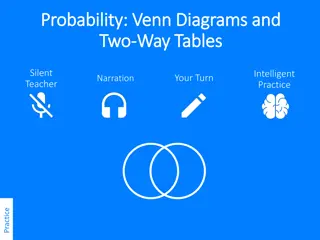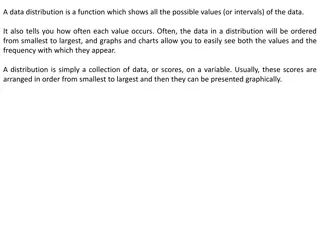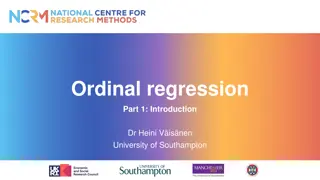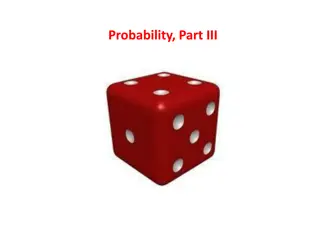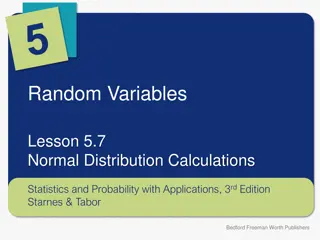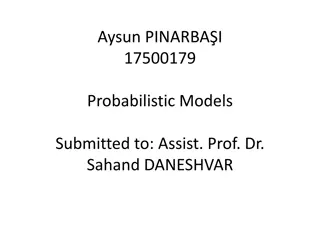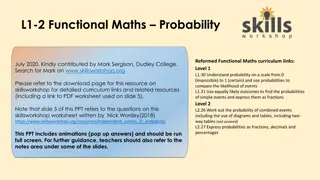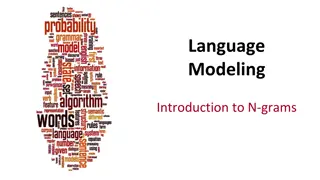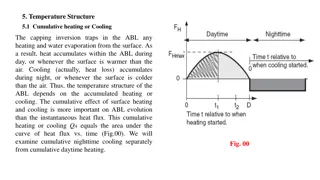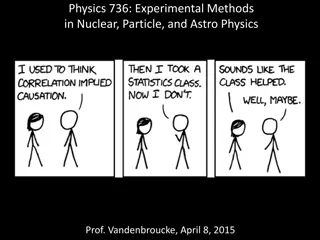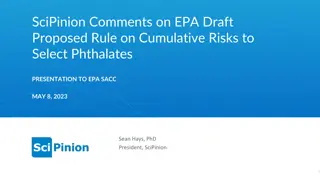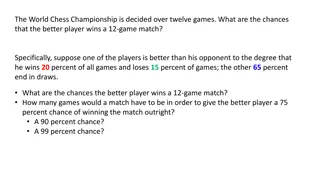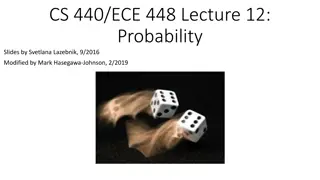Multivariate Analysis
Explore the key concepts of marginal, conditional, and joint probability in multivariate analysis, as well as the notion of independence and Bayes' Theorem. Learn how these probabilities relate to each other and the importance of handling differences in joint and marginal probabilities.
5 views • 43 slides
Understanding Conditional Probability and Bayes Theorem
Conditional probability relates the likelihood of an event to the occurrence of another event. Theorems such as the Multiplication Theorem and Bayes Theorem provide a framework to calculate probabilities based on prior information. Conditional probability is used to analyze scenarios like the relati
1 views • 5 slides
Importance of Cumulative Record Cards in Education
A Cumulative Record Card is a vital document that contains essential information about a student's academic performance, attendance, health, and more. It serves as a comprehensive record that aids in the student's development throughout their school journey and helps in addressing educational, vocat
1 views • 12 slides
Understanding Dushi Visha: A Cumulative Poison in Ayurveda
Dushi Visha is a unique concept in Ayurveda, referring to a cumulative poison that accumulates in the body due to prolonged exposure. Originating from various sources, it manifests poisoning effects over time, affecting the dhatus and immunity of individuals. With subtle symptoms and effects on diff
1 views • 13 slides
Understanding Probability Rules and Models
Probability rules and models explain how to calculate the likelihood of different outcomes in a chance process by utilizing sample spaces, probability models, events, and basic rules of probability. Learn about the importance of sample space, probability models, calculating probabilities, mutually e
0 views • 17 slides
Guidelines for Lecturer Evaluations and Entitlements at CPP
This document outlines the evaluation process for lecturers at CPP, including annual and cumulative evaluations, who needs to be evaluated, the importance of cumulative evaluations, and the time periods covered by evaluations. It explains the criteria for evaluations, ensuring fair assessment and pr
1 views • 10 slides
Probability and Two-Way Tables Practice Examples
Explore various probability scenarios through Venn diagrams and two-way tables in this practice session. Calculate probabilities of students liking specific sports and subjects, and determine conditional probabilities based on given conditions. Enhance your understanding of probability concepts with
0 views • 7 slides
Understanding Data Distribution and Normal Distribution
A data distribution represents values and frequencies in ordered data. The normal distribution is bell-shaped, symmetrical, and represents probabilities in a continuous manner. It's characterized by features like a single peak, symmetry around the mean, and standard deviation. The uniform distributi
1 views • 23 slides
Understanding Probability of Simple Events
Explore the concept of probability by learning about simple events, outcomes, and calculating probabilities using favorable outcomes. Discover how to express probability as fractions, decimals, or percentages through real-world examples like coin flips and dice rolls. Enhance your understanding of c
1 views • 13 slides
Understanding Ordinal Regression in Data Analysis
Introduction to ordinal regression, a powerful tool for analyzing categorical variables with natural ordering. Explore cumulative odds, probabilities, and the proportional odds model. Learn about estimating equations, intercepts, and slopes in ordinal regression models. Discover how higher values of
1 views • 15 slides
Understanding Probability: Theory and Examples
Explore the concepts of probability through the classical theory introduced by Pierre-Simon Laplace in the 18th century. Learn about assigning probabilities to outcomes, the uniform distribution, and calculating probabilities of events using examples like coin flipping and biased dice rolls.
0 views • 14 slides
Understanding Probability Concepts and Calculation Methods
Learn about independent and non-independent events, multiplication rule for independent events, ways of determining probabilities theoretically and empirically, and calculating probabilities when outcomes are equally likely using examples like dice rolls. Explore the concepts of disjointness versus
0 views • 17 slides
Understanding Conditional Probability and Independence in Statistics
Conditional probability and independence are essential concepts in statistics. This lesson covers how to find and interpret conditional probabilities using two-way tables, calculate probabilities using the conditional probability formula, and determine the independence of events. Through examples li
0 views • 15 slides
Understanding Normal Distribution Calculations in Statistics
Exploring normal distribution calculations in Statistics involves calculating probabilities within intervals and finding values corresponding to given probabilities. This lesson delves into the application of normal distribution to determine probabilities of scoring below a certain level on tests an
1 views • 13 slides
Understanding Gillette Injuries in Minnesota Workers' Compensation
In Minnesota workers' compensation, Gillette injuries refer to cumulative trauma that disables an employee over time, as opposed to a distinct event. These injuries are recognized based on the Gillette v. Harold case, where the Minnesota Supreme Court highlighted the cumulative effects of daily work
0 views • 36 slides
Understanding Probabilistic Models: Examples and Solutions
This content delves into probabilistic models, focusing on computing probabilities by conditioning, independent random variables, and Poisson distributions. Examples and solutions are provided to enhance understanding and application. It covers scenarios such as accidents in an insurance company, ge
0 views • 12 slides
Vestige Marketing Plan Overview
The Vestige Marketing Plan offers a 4-fold bonus structure with cumulative rewards and no demotions. Distributors can earn income through retail profit, performance bonuses, director bonuses, leadership overriding bonuses, and various incentive funds. The plan emphasizes one-time achievements, downw
0 views • 16 slides
Understanding Probability in Functional Maths Curriculum
Explore probability concepts in functional maths, such as understanding probability scales, comparing likelihood of events, calculating probabilities of simple and combined events, and expressing probabilities as fractions, decimals, and percentages. Practice drawing probability lines, simplifying f
0 views • 8 slides
California Communities Environmental Health Screening Tool (Cal-EnviroScreen) Overview
California Communities Environmental Health Screening Tool, known as Cal-EnviroScreen, is a program that focuses on environmental justice, aiming to ensure fair treatment for all individuals concerning environmental laws. The initiative addresses concerns related to cumulative impacts of pollution o
0 views • 27 slides
Development of Cumulative Fission Yield Covariances for Uncertainty Quantification
This study by A.A. Sonzogni and E.A. McCutchan focuses on developing cumulative fission yield covariances for uncertainty quantification in nuclear reactors. The research involves calculating cumulative fission yields, using decay data and nuclear databases, to improve accuracy in predicting fission
0 views • 5 slides
Understanding Bayes Theorem in NLP: Examples and Applications
Introduction to Bayes Theorem in Natural Language Processing (NLP) with detailed examples and applications. Explains how Bayes Theorem is used to calculate probabilities in diagnostic tests and to analyze various scenarios such as disease prediction and feature identification. Covers the concept of
0 views • 13 slides
Understanding Stock Valuation and Voting Rights in Corporation Governance
Features of common and preferred stocks, voting rights in straight and cumulative voting, and the cost to secure a seat on a board of directors in a corporation with cumulative voting are discussed. The differences between straight voting and cumulative voting, the impact of staggering elections in
0 views • 32 slides
Introduction to N-grams and Language Modeling
Language modeling is essential for tasks like machine translation, spell correction, speech recognition, summarization, and question-answering. Dan Jurafsky explains the goal of assigning probabilities to sentences, computing the probability of word sequences, and applying the Chain Rule to compute
0 views • 78 slides
Enhancing Family Services for Neglected Children and Families
This paper by Richard P. Barth, PhD, discusses the importance of evidence-informed family services for neglected children and families. It emphasizes the need for real-time applications of family information, broader focus on evidence-based family work, and interdisciplinary practices to prevent chi
0 views • 47 slides
Faculty Evaluations: Periods, Deadlines & Procedures
Annual and cumulative evaluations for temporary and tenured faculty are essential in the academic setting. Annual evaluations cover the past year's teaching activities while cumulative evaluations consider a longer timeframe. Deadlines and review processes are detailed in the evaluation calendar for
0 views • 12 slides
Understanding Infiltration and Unsaturated Flow in Hydrology
This content delves into the key concepts of infiltration and unsaturated flow in hydrology, focusing on calculating infiltration, cumulative infiltration, and time to ponding using the Green-Ampt method. It covers important topics such as runoff rate, infiltration capacity, cumulative infiltration,
0 views • 8 slides
Comparison of Compound DC Motors and Their Characteristics
Compound DC motors, including cumulative, differential, and compound configurations, offer unique operational features based on how the series and shunt field windings are connected. Cumulative compound motors provide improved torque characteristics but lower speed, while differential compound motor
0 views • 12 slides
Understanding Temperature Structure and Cumulative Heating/Cooling in Atmospheric Boundary Layer
The temperature structure in the atmospheric boundary layer (ABL) is influenced by cumulative heating or cooling effects from the surface. During the day, heat accumulates within the ABL, while cooling occurs at night. The cumulative heating or cooling is more crucial for ABL evolution than instanta
0 views • 12 slides
Review of Common Algorithms and Probability in Computer Science
Exploring common quicksort implementations, algorithms with probabilities of failure, and small probabilities of failure in computer science. The content covers concepts like combinatorics, probability, continuous probability, and their applications in computer science and machine learning. Strategi
0 views • 15 slides
Understanding Decisions Under Risk and Uncertainty
Decisions under risk involve outcomes with known probabilities, while uncertainty arises when outcomes and probabilities are unknown. Measuring risk involves probability distributions, expected values, and variance calculations. Expected profit is determined by weighting profits with respective prob
0 views • 45 slides
Bachelor Semester Declaration Systems Comparison
Bachelor semester declaration systems differ between the Virtual Dean's Office and USOS. In the Virtual Dean's Office system, students are grouped based on admission assessment, cumulative average, field of study, and preferences. Meanwhile, in the USOS system, grouping criteria include admission as
0 views • 7 slides
Understanding Statistical Distributions in Physics
Exploring the connections between binomial, Poisson, and Gaussian distributions, this material delves into probabilities, change of variables, and cumulative distribution functions within the context of experimental methods in nuclear, particle, and astro physics. Gain insights into key concepts, su
0 views • 13 slides
Evaluation of Phthalates Cumulative Risks: Expert Insights
SciPinion presented findings and opinions on the EPA Draft Proposed Rule concerning cumulative risks associated with select phthalates. An expert panel, including former EPA scientists, shared perspectives on chemical grouping, the Phthalate Syndrome terminology, specific phthalates relevance, and t
1 views • 11 slides
Understanding Different Types of Shares in a Company
Shares in a company represent ownership in its share capital, with different classes like preference shares and equity shares offering varying rights and benefits to shareholders. Preference shares can be further categorized into cumulative, non-cumulative, participating, non-participating, redeemab
0 views • 11 slides
Cumulative Effects of Development and Climate Change on Caribou Population
This progress report by Don Russell on the cumulative effects of development and climate change on the Porcupine Caribou Herd (PCH) discusses findings related to climate analysis, winter range selection behavior, modeling the impacts of climate change and development on caribou body size, energy-pro
0 views • 9 slides
Probabilities in World Chess Championship Matches
The chances of a better player winning a 12-game match in the World Chess Championship can be calculated based on the probabilities of winning, losing, and drawing individual games. By expanding the expression representing the match outcomes, we find that the better player has approximately a 52% ch
1 views • 5 slides
Understanding Probability: Learning Outcomes and Examples
This content delves into the study of probability, covering topics such as representing probabilities of simple and compound events, calculating relative frequencies, multi-step chance experiments, theoretical and experimental probabilities. It explains concepts like chance experiments, sample space
0 views • 31 slides
Understanding Probability and Decision Making Under Uncertainty
Probability theory plays a crucial role in decision-making under uncertainty. This lecture delves into key concepts such as outcomes, events, joint probabilities, conditional independence, and utility theory. It explores how to make decisions based on probabilities and expected utility, highlighting
0 views • 34 slides
Analysis of Fakes on Trial Experiment Conducted by NSW Department of Education
The NSW Department of Education conducted an experiment called "Fakes on Trial" to explore concepts of probability and experimental outcomes. The experiment involved students predicting coin toss results, calculating probabilities, and comparing observed results with theoretical probabilities. Throu
0 views • 11 slides
Insights into Eye Color Phenotypes and Probabilities
Understanding eye color phenotypes and probabilities through visual analysis of data from Ireland, Greece, and Poland. Utilizing programming techniques to create colorized scatterplots, frequency tables, and probability lists. Observations reveal how high probabilities of certain eye colors translat
1 views • 7 slides






